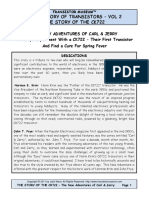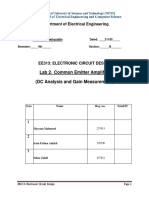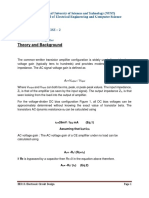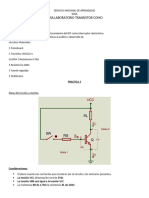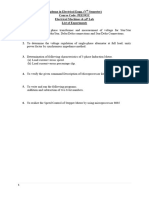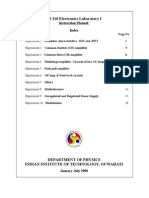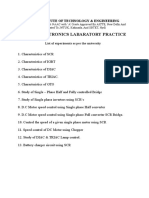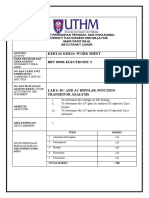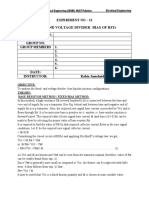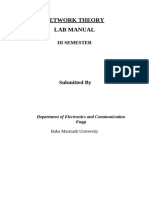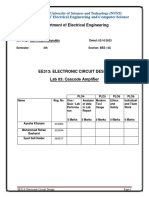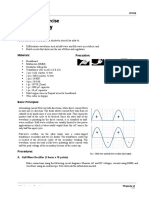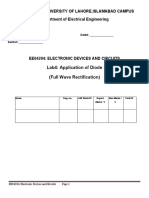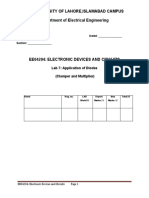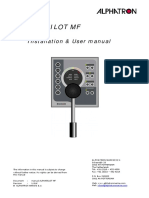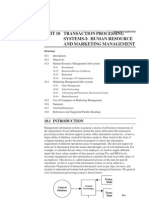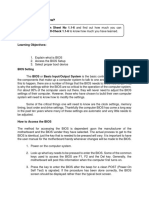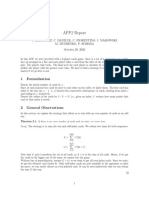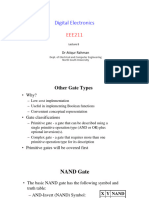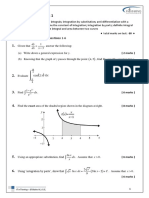EDC Lab No.8 (BJT Common Emitter I-V Characteristics)
EDC Lab No.8 (BJT Common Emitter I-V Characteristics)
Uploaded by
Umair WaqasCopyright:
Available Formats
EDC Lab No.8 (BJT Common Emitter I-V Characteristics)
EDC Lab No.8 (BJT Common Emitter I-V Characteristics)
Uploaded by
Umair WaqasOriginal Title
Copyright
Available Formats
Share this document
Did you find this document useful?
Is this content inappropriate?
Copyright:
Available Formats
EDC Lab No.8 (BJT Common Emitter I-V Characteristics)
EDC Lab No.8 (BJT Common Emitter I-V Characteristics)
Uploaded by
Umair WaqasCopyright:
Available Formats
THE UNIVERSITY OF LAHORE,ISLAMABAD CAMPUS
Department of Electrical Engineering
Semester:_____________ Dated: ________________
Section: ________________
EE04204: ELECTRONIC DEVICES AND CIRCUITS
Lab 8: BJT Common Emitter I-V characteristics
Name Reg. no. LAB Work/15 Report Viva Marks / Total/25
Marks / 5 5
EE04204: Electronic Devices and Circuits Page 1
THE UNIVERSITY OF LAHORE,ISLAMABAD CAMPUS
LABORATORY EXERCISE-8
BJT I-V Characteristics (Common Emitter)
Objective: To study current-voltage characteristics of BJTs
The primary purpose of this lab is to develop a working knowledge of Bipolar Junction Transistor (BJT).
Transistors are current controlled devices which find applications in a vast array of circuits including but
not limited to amplifiers, electronic switches, multipliers etc.
First, the students will learn the method that is used to determine the type of the transistor and find out
and label various terminals of the BJT.
Other parts deal with the study the I-V characteristics of the BJT, and see how varying the parameters
of the BJT affect them. For our implementation and simulation phase the 2N2222 transistor will be used
which is one of the popular type of BJT around.
Required Resources
The following components, test equipment and software would be required.
2N2222 Transistor
DMM
Oscilloscope
Resistors
Capacitors
Power Supply
Proteus Simulation Software.
The Experiment
The experiment is broken down in two exercises; Exercise 2 is divided into two parts namely: simulation and
implementation. You are required to observe and record the simulation/implementation results and answer the
given questions. Include your answers in your lab reports.
Exercise 1: BJT Type Identification (Implementation-I)
In this part of the experiment you will be given a sample transistor and using the procedure below you are
required to determine whether the transistor is an NPN or PNP transistor. You are also required to identify the
terminals of the transistor.
Procedure
Set your digital multi-meter to diode check mode.
The physical packing and shape of 2N2222 transistor is shown in figure-1. Mark your
terminals as 1, 2 and 3.
Now, connect the probes of the multi-meter to any two terminals of the transistor and
observe the readings. Interchange the positive and negative leads of the DMM and observe
the new reading.
Record your observations in the form of a table.
The two terminals for which your DMM shows a high or out of range reading even after
reversing the order of the probes are the collector and the emitter. The third terminal is
obviously the base.
The lower of the two “finite” readings that are measured correspond to the base-collector
junction.
EE04204: Electronic Devices and Circuits Page 2
THE UNIVERSITY OF LAHORE,ISLAMABAD CAMPUS
To determine the type of transistor, you are required to use your previous knowledge of
diodes and their biasing modes to determine whether the transistor is of NPN or PNP type.
2N2222 Packaging
Figure 1 Physical packing of 2N2222
Observations/Measurements and Explanation:
Accomplish the following and explain your results:
Tabulate your observations in the form of a table clearly showing the order of the connection of
the probes to the terminals and the corresponding reading on the DMM.
Identify each of the terminals.
Explain why the diode check reading for the collector base junction is lower than the emitter
base junction?
How will you determine whether the transistor is NPN or PNP type?
Exercise 2 Part A:
Common Emitter I-V Characteristics of the BJT (Simulation-I)
In this part the students will study the common emitter I-V characteristics of a BJT. In particular relationship
between the collector current and the voltage that appears across the collector-emitter junction of the transistor
will be observed. Further, the effect of various parameters like, saturation current, early voltage etc. on the
transistor I-V characteristics will be studied.
Procedure:
1. Using Proteus software, draw the circuit as shown in figure 2A.
2. The test circuit in figure 2A is used to determine the dependence of the collector current on the
base-emitter voltage as well as the voltage applied at the collector. The source VBB in figure 2A
controls the amount of base-emitter voltage and the current that enters the base terminal and
the source VCC controls the voltage that appears at the collector terminal.
3. In the first simulation run, set the value of R1 = 1Ω.
4. Create an appropriate simulation profile to perform DC Sweep Analysis.
5. Sweep the collector voltage from 0 to 30 V.
6. Set the base voltage at values between 0.5V and 0.8V in steps of 0.1 V and obtain a i C vs vCE
graph using dc sweep analysis..
7. Now do a second simulation run using R1 = 220Ω. Repeat steps (4) to (8)
8. Kindly make sure that your graph is neat, clear and labeled correctly.
EE04204: Electronic Devices and Circuits Page 3
THE UNIVERSITY OF LAHORE,ISLAMABAD CAMPUS
B2
I2(1)
R2
1
R1 Q1
2N2222
2.2
B1
0.4V
Figure 2A Test Circuit for Common Emitter Characteristics of BJT
Observations/Measurements
Answer the following questions and include them in your report. Support your answers by mathematical
equations where necessary.
o For each value of Base voltage VBB,, selected above,, (in steps of 0.1V) calculate the
value of the base current IB.
o Calculate the average value of β for each value of base current. Comment on and
explain the trend that you observe.
o On the IC versus VCE plot, identify each region of operation of the transistor.
o Why does the graph of the collector current have a considerable slope in the active
region of the transistor? Explain.
o Calculate the Early voltage of the transistor using the gradient of the plot that you have
obtained.
Exercise 2 Part B:
Common Emitter I-V Characteristics of the BJT (Implementation-II)
This exercise involves the implementation of a circuit to test the I-V characteristic of a BJT which you have
extensively studied through the simulation phase of the experiment.
Patch the circuit as shown in figure 2B.
For a fixed value of VBB, vary VCC in steps of 1V from 0 to 9 volts and record the values of IB, IC
and VCE. Take sufficient readings.
Change the value of VBB in steps of 0.1V and for each valve of VBB ,calculate and tabulate the
values of β.
EE04204: Electronic Devices and Circuits Page 4
THE UNIVERSITY OF LAHORE,ISLAMABAD CAMPUS
Plot the collector current versus collector emitter voltage using your data points in MS Excel and
include it in your report
B2
0V-9V
R2
220
R1 Q1
2N2222
2.2
B1
0.6V-0.9V
Figure 2B – Circuit Diagram for Implementation-II
Observations/Measurements and Explanations
Answer the following questions:
Compare the graphs that you have obtained from Simulation-I and Implementation-II. Are they similar?
If not, explain the differences.
Calculate the early voltage based on the IC-VCE graphs that you have obtained. Compare with the value
that you have obtained from Simulation-I.
Try and change the values of the resistances and observe its effect on the IC-VCE curve. What changes
do you observe? Is there any change in the slope of the graph in the active region? Comment in each
case.
Lab Report:
Each student group has to submit detailed lab report with proper outputs and results obtained
by performing experiment. The format of the report should be as explained by the course
instructor. Your lab report is due before the next lab.
EE04204: Electronic Devices and Circuits Page 5
You might also like
- The STORY of The CK722 - The New Adventures of Carl & Jerry (2011) Jack Ward..Document10 pagesThe STORY of The CK722 - The New Adventures of Carl & Jerry (2011) Jack Ward..eeeagleNo ratings yet
- EDC Lab 10Document14 pagesEDC Lab 10uf73735No ratings yet
- ECD Lab 6Document6 pagesECD Lab 6Rakhmeen gulNo ratings yet
- Zener LimiterDocument5 pagesZener LimitersameeNo ratings yet
- EDC Lab No.9 (BJT ApplicationsTransistor Switches-Security Alarm)Document4 pagesEDC Lab No.9 (BJT ApplicationsTransistor Switches-Security Alarm)sameeNo ratings yet
- Course: Electronic Circuit Devices Lab No: 02 Title: Bipolar Junction Transistor DC Response. CID: - DateDocument6 pagesCourse: Electronic Circuit Devices Lab No: 02 Title: Bipolar Junction Transistor DC Response. CID: - DateAamir ChohanNo ratings yet
- ECD Lab 2 PDFDocument12 pagesECD Lab 2 PDFMaryam MahmoodNo ratings yet
- UIU Lab ReportDocument38 pagesUIU Lab Reportnaholob951No ratings yet
- ECE321 - 6th EXPDocument4 pagesECE321 - 6th EXPمحمد ابراهيمNo ratings yet
- ECD Lab 2Document6 pagesECD Lab 2Maryam MahmoodNo ratings yet
- Experiment 3 Lab ManualDocument5 pagesExperiment 3 Lab ManualutbdchannelNo ratings yet
- Introduction To ElectromicsDocument13 pagesIntroduction To ElectromicsChaztan RajNo ratings yet
- 2021-22 ADE Lab Manual (New Syllabus)Document70 pages2021-22 ADE Lab Manual (New Syllabus)psaikiranyadav15No ratings yet
- C-20 P e Practicle ComletetDocument80 pagesC-20 P e Practicle Comletetamrutha cNo ratings yet
- Diode, BJT, Zener, MosfetDocument10 pagesDiode, BJT, Zener, MosfetSundar Krishna MoorthyNo ratings yet
- Power Electronics Lab Manual With LogoDocument69 pagesPower Electronics Lab Manual With LogoPunith Gowda M BNo ratings yet
- 6-ECD Lab 6 (1) Saad NadeemDocument8 pages6-ECD Lab 6 (1) Saad NadeemSaad NadeemNo ratings yet
- Lab 10 BJT - PrintDocument11 pagesLab 10 BJT - PrintAmalina Ismail100% (1)
- Laboratory Instruction Sheet: Jabatan Pendidikan Kejuruteraan Fakulti Pendidikan Teknikal Dan VokasionalDocument4 pagesLaboratory Instruction Sheet: Jabatan Pendidikan Kejuruteraan Fakulti Pendidikan Teknikal Dan VokasionalBlank BlankNo ratings yet
- EDC Lab No.9 (BJT ApplicationsTransistor Switches-Security Alarm)Document4 pagesEDC Lab No.9 (BJT ApplicationsTransistor Switches-Security Alarm)Umair WaqasNo ratings yet
- SKEE 2742 Basic Electronics Lab: Experiment 2 BJT Small-Signal AmplifierDocument8 pagesSKEE 2742 Basic Electronics Lab: Experiment 2 BJT Small-Signal Amplifierمحمد ابو جرادNo ratings yet
- Inbound 9063415420354614974Document5 pagesInbound 9063415420354614974jesuspenildoNo ratings yet
- Electrical Engineering Department Dee 30071 - Electronic Computer Aided DesignDocument6 pagesElectrical Engineering Department Dee 30071 - Electronic Computer Aided DesignTharanidaran 23No ratings yet
- ET1310 Lab 2.1 LabReportHandout OLDocument8 pagesET1310 Lab 2.1 LabReportHandout OLIreri MwanikiNo ratings yet
- ENGR2200 Lab Manual Lab2Document12 pagesENGR2200 Lab Manual Lab2Sure TipsNo ratings yet
- Indian Institute of Technology Ropar Electrical Engineering DepartmentDocument3 pagesIndian Institute of Technology Ropar Electrical Engineering Departmentrahul.23eez0004No ratings yet
- Pee 592CDocument17 pagesPee 592CsaadiarsalurrehmanNo ratings yet
- PH210 Lab ManualDocument23 pagesPH210 Lab ManualAshish AgrawalNo ratings yet
- مختبر الدوائر الاردن PDFDocument43 pagesمختبر الدوائر الاردن PDFMarwan M MuharramNo ratings yet
- Experiment 3 Network Theorems (1) Nodal & Mesh AnalysisDocument4 pagesExperiment 3 Network Theorems (1) Nodal & Mesh Analysishamzah dayyatNo ratings yet
- ELE-LAB1 - N°2 - Diodes and Transistor Based Two Input - 240925 - 130929Document3 pagesELE-LAB1 - N°2 - Diodes and Transistor Based Two Input - 240925 - 130929thrasyprideNo ratings yet
- EEC ActivityDocument13 pagesEEC ActivityKerwin James AustriaNo ratings yet
- Al-Balqa' Applied University: Electronics LabDocument54 pagesAl-Balqa' Applied University: Electronics Labahmad abufaresNo ratings yet
- Project ReportDocument20 pagesProject ReportUddesh ChakrabortyNo ratings yet
- List of ExperimentsDocument78 pagesList of ExperimentsmurthyNo ratings yet
- Exp#9 Common Emitter ConfigurationDocument9 pagesExp#9 Common Emitter ConfigurationHussain HadiNo ratings yet
- Teaching 374 3302 1527534121Document47 pagesTeaching 374 3302 1527534121RavikanthSivangiNo ratings yet
- Bee Lab12Document5 pagesBee Lab12Hisham AliNo ratings yet
- IEexptPDFDocument78 pagesIEexptPDFcpabustan100% (3)
- Lab Report EetDocument4 pagesLab Report EetMuhd HaidharNo ratings yet
- Kertas Kerja /work Sheet BBV 30303-Electronic 2Document7 pagesKertas Kerja /work Sheet BBV 30303-Electronic 2Blank BlankNo ratings yet
- Workshop 02Document5 pagesWorkshop 02Damith ErangaNo ratings yet
- Fixed-And Voltage Divider - Bias of BJTS: Experiment No - 12Document39 pagesFixed-And Voltage Divider - Bias of BJTS: Experiment No - 12Muhammad HamzaNo ratings yet
- Lab 8Document10 pagesLab 8Mike AlbertNo ratings yet
- EEC ActivityDocument19 pagesEEC ActivityKerwin James AustriaNo ratings yet
- Lab Manual of Applied Science II (Physics) : Jawaharlal Nehru Engineering College, AurangabadDocument9 pagesLab Manual of Applied Science II (Physics) : Jawaharlal Nehru Engineering College, Aurangabadtssatish007No ratings yet
- NT Lab MannualDocument25 pagesNT Lab Mannualsidhantfi9haiNo ratings yet
- Electronic Devices and Circuits-Manual - August 2018Document92 pagesElectronic Devices and Circuits-Manual - August 2018Qasim LodhiNo ratings yet
- LabInstr EE320L Lab7Document9 pagesLabInstr EE320L Lab7baig79No ratings yet
- Department of Electrical Engineering EE363: Power ElectronicsDocument11 pagesDepartment of Electrical Engineering EE363: Power ElectronicsTalha RiazNo ratings yet
- Opto CouplerDocument9 pagesOpto CouplerPadmo PadmundonoNo ratings yet
- Lab 03Document7 pagesLab 03Rehan BasharatNo ratings yet
- Lab 2Document8 pagesLab 2Richard MillerNo ratings yet
- Course: Electronic Circuit Devices Lab No: 03 Title: Common Biasing Techniques of BJT CID: - DateDocument5 pagesCourse: Electronic Circuit Devices Lab No: 03 Title: Common Biasing Techniques of BJT CID: - DateAamir ChohanNo ratings yet
- Lab #2 - DiodesDocument16 pagesLab #2 - DiodescrackintheshatNo ratings yet
- Lab 3Document4 pagesLab 3J SarduaNo ratings yet
- EE2002 Assignment1 2021s2Document6 pagesEE2002 Assignment1 2021s2Goh Cai YuNo ratings yet
- Power Supply: Laboratory ExerciseDocument4 pagesPower Supply: Laboratory ExercisejjNo ratings yet
- Design of Electrical Circuits using Engineering Software ToolsFrom EverandDesign of Electrical Circuits using Engineering Software ToolsNo ratings yet
- Electromagnetic Compatibility (EMC) Design and Test Case AnalysisFrom EverandElectromagnetic Compatibility (EMC) Design and Test Case AnalysisNo ratings yet
- EDC Lab 4Document5 pagesEDC Lab 4Umair WaqasNo ratings yet
- EDC Lab No.7 (Clamper and Multiplier)Document5 pagesEDC Lab No.7 (Clamper and Multiplier)Umair WaqasNo ratings yet
- EDC Lab No.9 (BJT ApplicationsTransistor Switches-Security Alarm)Document4 pagesEDC Lab No.9 (BJT ApplicationsTransistor Switches-Security Alarm)Umair WaqasNo ratings yet
- Lab Report 5Document18 pagesLab Report 5Umair WaqasNo ratings yet
- DLD Lab Report 2Document9 pagesDLD Lab Report 2Umair WaqasNo ratings yet
- L3VPN Basic On Segment RoutingDocument10 pagesL3VPN Basic On Segment RoutingAlex MachadoNo ratings yet
- Sachin JavaDocument19 pagesSachin JavasatNo ratings yet
- PilotRiv AM AlphaPilot MF User Manual 5-6-2020Document19 pagesPilotRiv AM AlphaPilot MF User Manual 5-6-2020valentin mocanuNo ratings yet
- Save Safari Page As PDF Iphone: Save Web Pages in Pdfs On Iphone or Ipad - ReaddleDocument3 pagesSave Safari Page As PDF Iphone: Save Web Pages in Pdfs On Iphone or Ipad - ReaddlemahdiNo ratings yet
- Transaction Processing System I - Human Resource and Marketing ManagementDocument9 pagesTransaction Processing System I - Human Resource and Marketing ManagementCamilo Amarcy0% (1)
- Reefer - Temperature RecordsDocument9 pagesReefer - Temperature RecordsdhaneshbhorNo ratings yet
- SPM Project Planning ProposalDocument32 pagesSPM Project Planning ProposalSurafelNo ratings yet
- Resume Ashwani MishraDocument8 pagesResume Ashwani Mishramdkamal0% (1)
- Beta 57-User GuideDocument12 pagesBeta 57-User GuideSava SavicNo ratings yet
- 20BCS2334 - Jitesh Kumar CVDocument3 pages20BCS2334 - Jitesh Kumar CVjiteshkumardjNo ratings yet
- WsCube Tech Paid-Ads-CourseDocument4 pagesWsCube Tech Paid-Ads-CourseProf.Mustansar HussainNo ratings yet
- Oralcee Apps NotesDocument256 pagesOralcee Apps NoteskotturvNo ratings yet
- Capstone 2 CorizoDocument2 pagesCapstone 2 Corizoavinashsharma231500No ratings yet
- Aksum UniversityDocument8 pagesAksum UniversityAnonymous MR1kCXPklzNo ratings yet
- CSS 11 - Week 5Document4 pagesCSS 11 - Week 5GREGORIO ALVAREZNo ratings yet
- APP2Document5 pagesAPP2Polina RohozaNo ratings yet
- IP - Chapter No 6-React JS-SH 2022-Prepared by Reshma KoliDocument38 pagesIP - Chapter No 6-React JS-SH 2022-Prepared by Reshma KoliVelmurgan SanthanamNo ratings yet
- Internet Overview: K.K.Dhupar Sde (DX), AlttcDocument40 pagesInternet Overview: K.K.Dhupar Sde (DX), Alttcshubhu11No ratings yet
- EEE 211 Lecture 8Document27 pagesEEE 211 Lecture 8fi7732803No ratings yet
- G DINESH Farm Manager Resume 2023 01 25 142701 PDFDocument2 pagesG DINESH Farm Manager Resume 2023 01 25 142701 PDFDinesh GnanamoorthyNo ratings yet
- Bentley MXROAD V8i Fundamental ASTASOFT Com PDFDocument2 pagesBentley MXROAD V8i Fundamental ASTASOFT Com PDFUmesh KumarNo ratings yet
- Infosec Career Paths v4Document1 pageInfosec Career Paths v4Esteban Eduardo GrijalvaNo ratings yet
- Activating Licenses Offline Using A Local License Server: January 2019Document11 pagesActivating Licenses Offline Using A Local License Server: January 2019Sergio RivasNo ratings yet
- Assignment No. 1 Transcription and Speed Building 1. How Do You Transcribe Laughter? Answer: HR A - F 2. How Do You Past A Transcription Test? AnswerDocument2 pagesAssignment No. 1 Transcription and Speed Building 1. How Do You Transcribe Laughter? Answer: HR A - F 2. How Do You Past A Transcription Test? AnswerJona BustamanteNo ratings yet
- 0wning Antivirus: Alex Wheeler Neel MehtaDocument39 pages0wning Antivirus: Alex Wheeler Neel MehtaHarish KhandelwalNo ratings yet
- Cisco IOS Firewall OverviewDocument8 pagesCisco IOS Firewall Overviewomar ayissaNo ratings yet
- Test1 HL Integral Calculus v1Document2 pagesTest1 HL Integral Calculus v1JUNIORNo ratings yet
- SSPC SP 1 PDFDocument3 pagesSSPC SP 1 PDFPipeMelgarejoLopezNo ratings yet
- Access Control For Secure Information ProtectionDocument8 pagesAccess Control For Secure Information ProtectionayomideNo ratings yet
